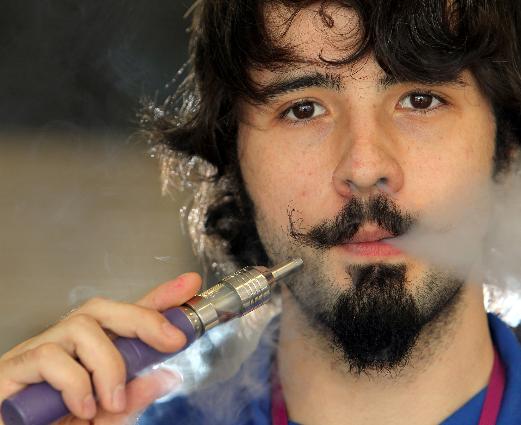Jury is out on health effects of e-cigarettes
By Monte Morin, Los Angeles Times
Electronic cigarettes are either a potent weapon in the war against tobacco, or they are an insidious menace that threatens to get kids hooked on nicotine and make smoking socially acceptable again.
There are health experts who back each point of view. But they do agree that the empirical evidence that will tell them who is right will not be in for several years.
“There are a few studies out there right now, but scientists like to have a gazillion,” said Stanton Glantz, a professor of medicine and director of the Center for Tobacco Control at UC San Francisco.
Among the most pressing questions for researchers: What are the long-term health effects of e-cigarettes on users and people around them? Do e-cigarettes help people kick the smoking habit, or do they actually make it harder? If kids start smoking e-cigarettes, are they likely to graduate to regular cigarettes?
“My big question with e-cigarettes is whether it puts youth on a pathway to smoking,” said acting Surgeon General Boris Lushniak, who will join other U.S. health officials Friday at the White House to commemorate the 50th anniversary of the surgeon general’s first report on the hazards of smoking.
When that landmark report was released in 1964, the proportion of U.S. adults who smoked was at an all-time high of 43%. By 2012, that figure had dropped to 18%. But without a renewed focus on the campaign against tobacco, the U.S. will miss its goal of reducing the national smoking rate to 12% by the end of the decade.
E-cigarettes are uniquely positioned to undo recent public health gains, Lushniak and others fear.
The battery-operated devices heat nicotine, propylene glycol and glycerin into a vapor, which is inhaled by the user. Unlike conventional tobacco-burning cigarettes, e-cigarettes do not deliver poisonous tars or carbon monoxide.
Currently, the devices are regulated only by a smattering of local governments who have passed laws concerning their sale and use. The Food and Drug Administration has the legal authority to regulate e-cigarettes as a tobacco product, but has not yet done so. In the meantime, e-cigarettes have grown to become a $2-billion industry with no federal oversight.
Though the FDA says propylene glycol and glycerin food additives are “generally regarded as safe,” the long-term effects of inhaling the substances are unknown. The FDA’s Center for Tobacco Products has begun collecting reports of adverse effects from e-cigarettes, and those complaints include claims of eye irritation, headaches and coughing.
E-cigarette backers say the health effects of the key component — nicotine — are well established and minimal for most everyone except pregnant mothers. They note that nicotine gum and patches have been used as smoking cessation tools for many years.
“It’s not the nicotine that’s the real enemy; it’s the way it’s burned and delivered in cigarettes,” said psychologist David Abrams, executive director of the American Legacy Foundation’s Schroeder Institute for Tobacco Research and Policy Studies in Washington. “In reasonable doses, and assuming good quality control, nicotine might raise your heart rate two or three beats per minute, but it really has few adverse effects.”
Yet that might not be true for teens. A surgeon general’s report released Friday says evidence now suggests that nicotine exposure during adolescence “may have lasting adverse consequences for brain development.”
And then there are the potential health effects on bystanders, who are also exposed to nicotine and propylene glycol emitted by the e-cigarette and its user.
Studies performed on e-cigarette vapor have detected heavy metals and volatile compounds such as formaldehyde, but the concentration and threat they pose has been hotly debated.
In a review of studies that examined e-cigarette mist, Drexel University environmental and occupational health expert Igor Burstyn concluded that “while these compounds are present, they have been detected at problematic levels only in a few studies that apparently were based on unrealistic levels of heating.”
Abrams took heart in that assessment, though he acknowledged that the vapor was not benign. Even so, the bystander effects are “almost immeasurable compared to the toxins in secondhand cigarette smoke,” he said.
That assessment may change when several studies examining fine particulate matter from e-cigarette vapor and their effects on the cardiovascular system are completed, Glantz said.
The burning question for most experts is whether e-cigarettes actually help people to quit smoking.
Researchers have conducted surveys that give them a “snapshot” of smoker behavior at a particular moment, but not over an extended period. Some results suggest e-cigarette users are continuing to smoke conventional cigarettes and relying on the electronic substitutes to satisfy nicotine cravings in the workplace, restaurants and other places where cigarettes are forbidden.
Another study published in the journal Lancet compared the effectiveness of e-cigarettes to nicotine patches and gum. Researchers said they expected e-cigarettes to be the clear winner, but it was a tie.
Now experts are looking toward long-term behavioral studies that will reveal how smokers actually use e-cigarettes. One such analysis by the FDA is set to begin field work this year, and will track about 60,000 smokers and nonsmokers for two years.
“It should tell us if people are using them for cessation, or as a gateway to traditional tobacco use,” said Brian King, an epidemiologist at the Centers for Disease Control and Prevention.
“There are a few studies out there right now, but scientists like to have a gazillion,” said Stanton Glantz, a professor of medicine and director of the Center for Tobacco Control at UC San Francisco.
Among the most pressing questions for researchers: What are the long-term health effects of e-cigarettes on users and people around them? Do e-cigarettes help people kick the smoking habit, or do they actually make it harder? If kids start smoking e-cigarettes, are they likely to graduate to regular cigarettes?
“My big question with e-cigarettes is whether it puts youth on a pathway to smoking,” said acting Surgeon General Boris Lushniak, who will join other U.S. health officials Friday at the White House to commemorate the 50th anniversary of the surgeon general’s first report on the hazards of smoking.
When that landmark report was released in 1964, the proportion of U.S. adults who smoked was at an all-time high of 43%. By 2012, that figure had dropped to 18%. But without a renewed focus on the campaign against tobacco, the U.S. will miss its goal of reducing the national smoking rate to 12% by the end of the decade.
E-cigarettes are uniquely positioned to undo recent public health gains, Lushniak and others fear.
The battery-operated devices heat nicotine, propylene glycol and glycerin into a vapor, which is inhaled by the user. Unlike conventional tobacco-burning cigarettes, e-cigarettes do not deliver poisonous tars or carbon monoxide.
Currently, the devices are regulated only by a smattering of local governments who have passed laws concerning their sale and use. The Food and Drug Administration has the legal authority to regulate e-cigarettes as a tobacco product, but has not yet done so. In the meantime, e-cigarettes have grown to become a $2-billion industry with no federal oversight.
Though the FDA says propylene glycol and glycerin food additives are “generally regarded as safe,” the long-term effects of inhaling the substances are unknown. The FDA’s Center for Tobacco Products has begun collecting reports of adverse effects from e-cigarettes, and those complaints include claims of eye irritation, headaches and coughing.
E-cigarette backers say the health effects of the key component — nicotine — are well established and minimal for most everyone except pregnant mothers. They note that nicotine gum and patches have been used as smoking cessation tools for many years.
“It’s not the nicotine that’s the real enemy; it’s the way it’s burned and delivered in cigarettes,” said psychologist David Abrams, executive director of the American Legacy Foundation’s Schroeder Institute for Tobacco Research and Policy Studies in Washington. “In reasonable doses, and assuming good quality control, nicotine might raise your heart rate two or three beats per minute, but it really has few adverse effects.”
Yet that might not be true for teens. A surgeon general’s report released Friday says evidence now suggests that nicotine exposure during adolescence “may have lasting adverse consequences for brain development.”
And then there are the potential health effects on bystanders, who are also exposed to nicotine and propylene glycol emitted by the e-cigarette and its user.
Studies performed on e-cigarette vapor have detected heavy metals and volatile compounds such as formaldehyde, but the concentration and threat they pose has been hotly debated.
In a review of studies that examined e-cigarette mist, Drexel University environmental and occupational health expert Igor Burstyn concluded that “while these compounds are present, they have been detected at problematic levels only in a few studies that apparently were based on unrealistic levels of heating.”
Abrams took heart in that assessment, though he acknowledged that the vapor was not benign. Even so, the bystander effects are “almost immeasurable compared to the toxins in secondhand cigarette smoke,” he said.
That assessment may change when several studies examining fine particulate matter from e-cigarette vapor and their effects on the cardiovascular system are completed, Glantz said.
The burning question for most experts is whether e-cigarettes actually help people to quit smoking.
Researchers have conducted surveys that give them a “snapshot” of smoker behavior at a particular moment, but not over an extended period. Some results suggest e-cigarette users are continuing to smoke conventional cigarettes and relying on the electronic substitutes to satisfy nicotine cravings in the workplace, restaurants and other places where cigarettes are forbidden.
Another study published in the journal Lancet compared the effectiveness of e-cigarettes to nicotine patches and gum. Researchers said they expected e-cigarettes to be the clear winner, but it was a tie.
Now experts are looking toward long-term behavioral studies that will reveal how smokers actually use e-cigarettes. One such analysis by the FDA is set to begin field work this year, and will track about 60,000 smokers and nonsmokers for two years.
“It should tell us if people are using them for cessation, or as a gateway to traditional tobacco use,” said Brian King, an epidemiologist at the Centers for Disease Control and Prevention.
http://www.latimes.com/science/la-sci-e-cigarettes-science-20140117,0,7562029.story#ixzz2qh59hXu7


